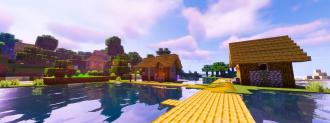In the video game Minecraft, players transform an undeveloped plot of land into an elaborate 3D city, unlike any that could exist in reality (or, sometimes, exactly like one that exists in reality).
But urban planning in Minecraft isn’t limited to gamers. An annual contest challenges programmers to develop AIs that can build cities in the game, too — and insights from the competition could one day help designers plot out cities in the real world.
The Minecraft Competition
The Generative Design in Minecraft Competition (GDMC) tasks programmers with developing an AI that can create a settlement on three Minecraft maps it had never seen before.
The AI should only need about 10 minutes to create each new city, and a team of judges then scores each creation based on four criteria, including the city’s functionality (e.g., could hypothetical residents navigate it?) and its adaptation to the initial environment (e.g., did the AI design roads to curve around mountains, or did it level the terrain and start from scratch?).
The GDMC organizers released the results of the judging on September 18, and a group known as “Troy, Ryan, and Trent” took home first place, beating out the 10 other competitors.
AI in Urban Planning
The entry that won the 2020 GDMC managed to create a city that looks a lot like a settlement a beginner Minecraft player might create, but urban planning in the real-world is far more complicated than in the video game.
City planners must consider countless variables — from how to lay out roads to avoid congestion to where to place parks to maximize residents’ access to green spaces — all while also taking into account budgets, zoning laws, and plans for future growth.
AI can do the “grunt work” of urban planning, freeing designers to focus on the creative.
AI is nowhere near ready to tackle the complicated task of designing an actual city from scratch on its own, but it can assist city planners, particularly when it comes to the quantitative aspects of urban planning.
An AI-powered platform created by Norwegian company Spacemaker, for example, can produce design options for city planners based on parameters they input, such as local building codes and zoning restrictions. Essentially, it does the computational “grunt work” necessary to ensure a design is feasible, freeing a designer to focus on the creative aspects.
Data analysis is another area where AI can assist with urban planning — algorithms can be trained to look for patterns in the available research on anything from improving traffic flow in a city to sustainable architecture. They can then provide an urban planner with insights that could help them design a better city.
Ultimately, competitions like GDMC can help identify even more ways for AI to assist in urban planning, Claus Aranha, an associate professor at the University of Tsukuba who advised three of this year’s entrants, told MIT Technology Review — perhaps one day leading the creation of systems that will be able to design cities for the real world and not just a virtual one.
We’d love to hear from you! If you have a comment about this article or if you have a tip for a future Freethink story, please email us at [email protected].






